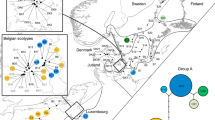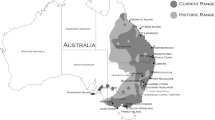Abstract
To elucidate the forees maintaining protein polymorphisms, microgeographic differentiation in proteins, encoded by 30 loci, was tested in 285 individuals comprising 3 species of landsnails in Israel. Each test consisted of 2 close subpopulations: one from the drier and warmer south-facing slope and the other from the opposite wetter and cooler north-facing slope. The 5 tests involved 2 of Buliminus labrosus in Mediterranean Count Carmel; 1 of Sphincterochila zonata in the northern, and 2 of S. prophetarum in the central Negev desert. The results indicate significant allele differences between the two slopes in several loci in each of the 5 local tests, involving primarily esterases (Est), aspartate aminotransferase (Aat) and leucine amino peptidases (Lap). The differential slope patterns appear to be adaptive, and are presumably maintained by microclimatic diversifying selection.
Similar content being viewed by others
References
Bar Z., 1975. Distribution and habitat of the genus Sphincterochila in Israel and Sinai. Argamon, Israel J. Malac. 5: 1–19.
Bradshaw A. D., 1972. Some of the evolutionary consequences of being a plant. Evol. Biol. 5: 25–47.
Brown A. H. D., 1979. Enzyme polymorphism in plant populations. Theor. Pop. Biol. 15: 1–42.
Felsenstein J., 1976. The theoretical population genetics of variable selection and migration. Ann. Rev. Genet. 10: 253–280.
Forcart L., 1972. Systematische stellung und unterteilung der gettung Sphincterochila. Ancey Arch. Moll. 102: 147–164.
Friedman, J., 1969. The role of competition in desert plant communities. PhD thesis. Hebrew University, Jerusalem (in Hebrew with English summary, unpublished).
Friedman J. & Elberse W. Th., 1976. Competition between two desert varieties of Medicago laciniata (L.) Mill., under controlled conditions. Oecologia (Berl.) 22: 321–339.
Gillespie J. H. & Kojima K., 1968. The degree of polymorphism in enzymes involved in energy production compared to that in nonspecific enzymes in two Drosophila ananassae populations. Proc. natn. Acad. Sci. U.S.A. 61: 582–585.
Hedrick P. H., Ginevan M. E. & Ewing E. P., 1976. Genetic polymorphism in heterogeneous environments. A. Rev. ecol. Syst. 7: 1–32.
Heller J., 1975. The taxonomy, distribution and faunal succession of Buliminus (Pulmonata: Enidae) in Israel. Zool. J. Linn. Soc. 57: 1–57.
Jain S. K., 1976. Patterns of survival and microevolution in plant populations. In: Population genetics and ecology (S. Karlin & E. Nevo, Eds). pp. 49–89. New York: Academic Press.
Karlin S., 1976. Population subdivision and selection migration interaction. In: ‘Population genetics and ecology’ (S. Karlin, E. Vevo, Eds) pp. 617–657, New York: Academic press.
Levene H., 1953. Genetic equilibrium when more than one ecological niche is available. Am. Nat. 87: 331–333.
Nevo E., 1978. Genetic variation in natural populations: Patterns and theory. Theor. Pop. Biol. 13: 121–177.
Nevo E. & Bar Z., 1976. Natural selection of genetic polymorphisms along climatic gradients. In: Population genetics and ecology. (S. Karlin & E. Nevo, eds) pp. 159–184; Academic Press, New York.
Nevo E., Shimeoni T. & Libni M., 1977. Thermal selection of allozyme polymorphisms in barnacles. Nature (London) 267: 699–701.
Nevo E., Shimeoni T. & Libni M., 1978. Pollution selection of allozyme polymorphisms in barnacles. Experientia 34: 1562–1564.
Nevo, E., Bar-El, Ch. & Bar, Z., 1981. Genetic diversity, climatic selection and speciation of Sphincterochila snails in Israel (submitted).
Platt J. R., 1964. Strong inference. Science 146: 347–349.
Powell J. R. & Taylor C. E., 1979. Genetic variation in ecologically diverse environments. Am. Scient. 67: 590–596.
Shachak M., Chapman E. A. & Orr Y., 1976. Some aspects of the ecology of the desert snail Sphincterochila boissieri in relation to water and energy flow. Israel J. medic. Sci. 12: 887–891.
Shachak M. & Steinberger Y., 1980. An algae-desert snail food chain: Energy flow and soil turnover. Oecologia (Berl.) 46: 402–411.
Schmidt-Nielsen K., Taylor C. R. & Shkolnik A., 1971. Desert snails: Problems of heat, water and food. J. exp. Bioll 55: 385–398.
Selander R. K., Smith M. H., Yang S. Y., Jonson W. E. & Gentry G. B., 1971. Biochemical polymorphism and systematics in the genus Peromyscus. I. Variation in the old fieldmouse (Peromyscus Polionotus). Univ. Texas Publ. 7103: 49–90.
Sharon, D., 1964. Microclimatological experiments at Nahal Sorek: Methodology and illustration. PhD thesis. Hebrew University, Jerusalem (Hebrew with English summary, unpublished)
Yom-Tov, Y., 1970. Investigation in the ecology and survival of two snails in the Negev desert. Ph.D. thesis, Tel-Aviv University (Hebrew, with English summary, unpublished).
Zohary M., 1973. Geobotanical foundations of the Middle East. Stuttgart: Fischer Verlag, pp. 738.
Author information
Authors and Affiliations
Rights and permissions
About this article
Cite this article
Nevo, E., Bar-El, C., Beiles, A. et al. Adaptive microgeographic differentiation of allozyme polymorphism in landsnails. Genetica 59, 61–67 (1982). https://doi.org/10.1007/BF00130815
Received:
Accepted:
Issue Date:
DOI: https://doi.org/10.1007/BF00130815




